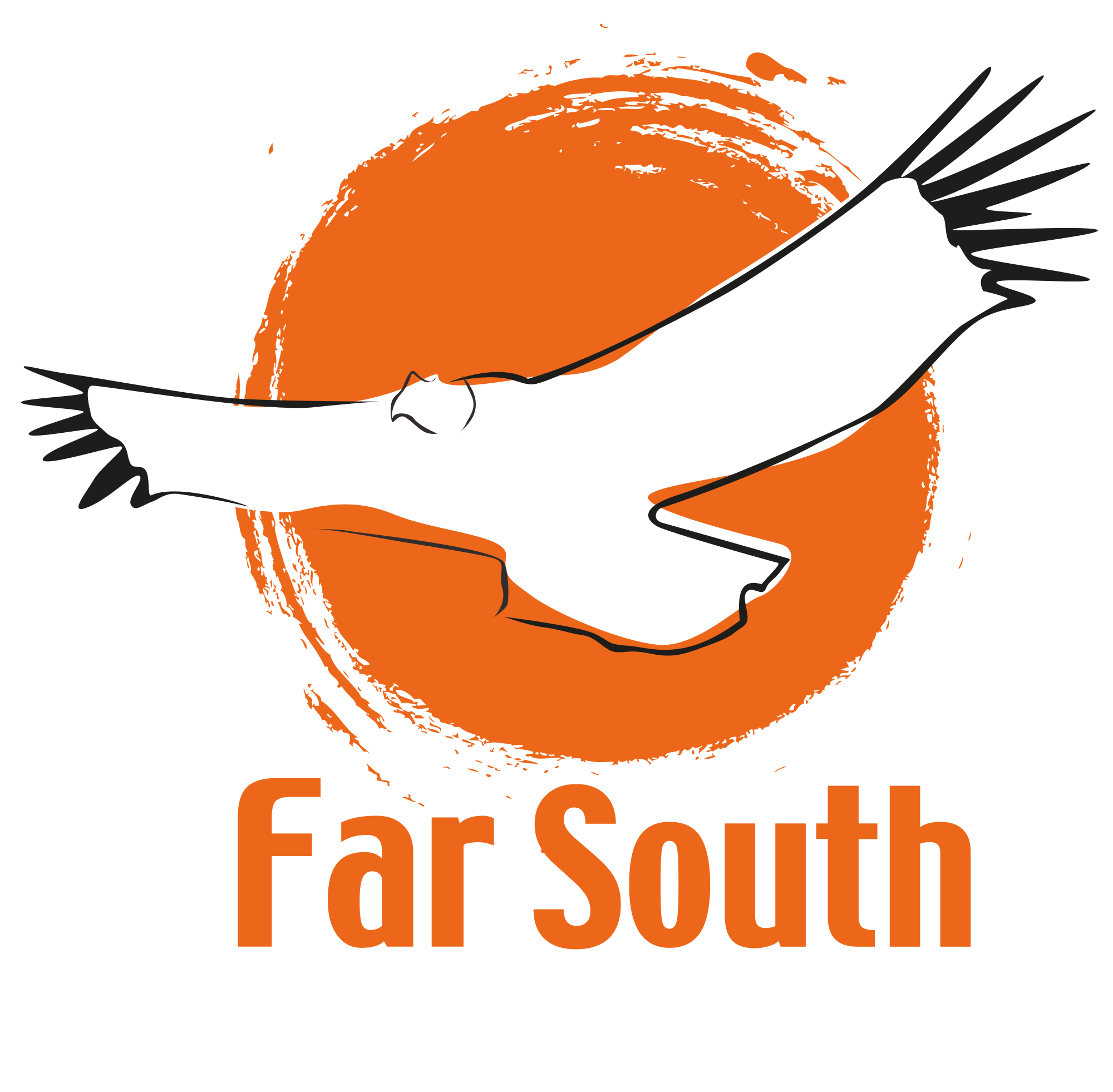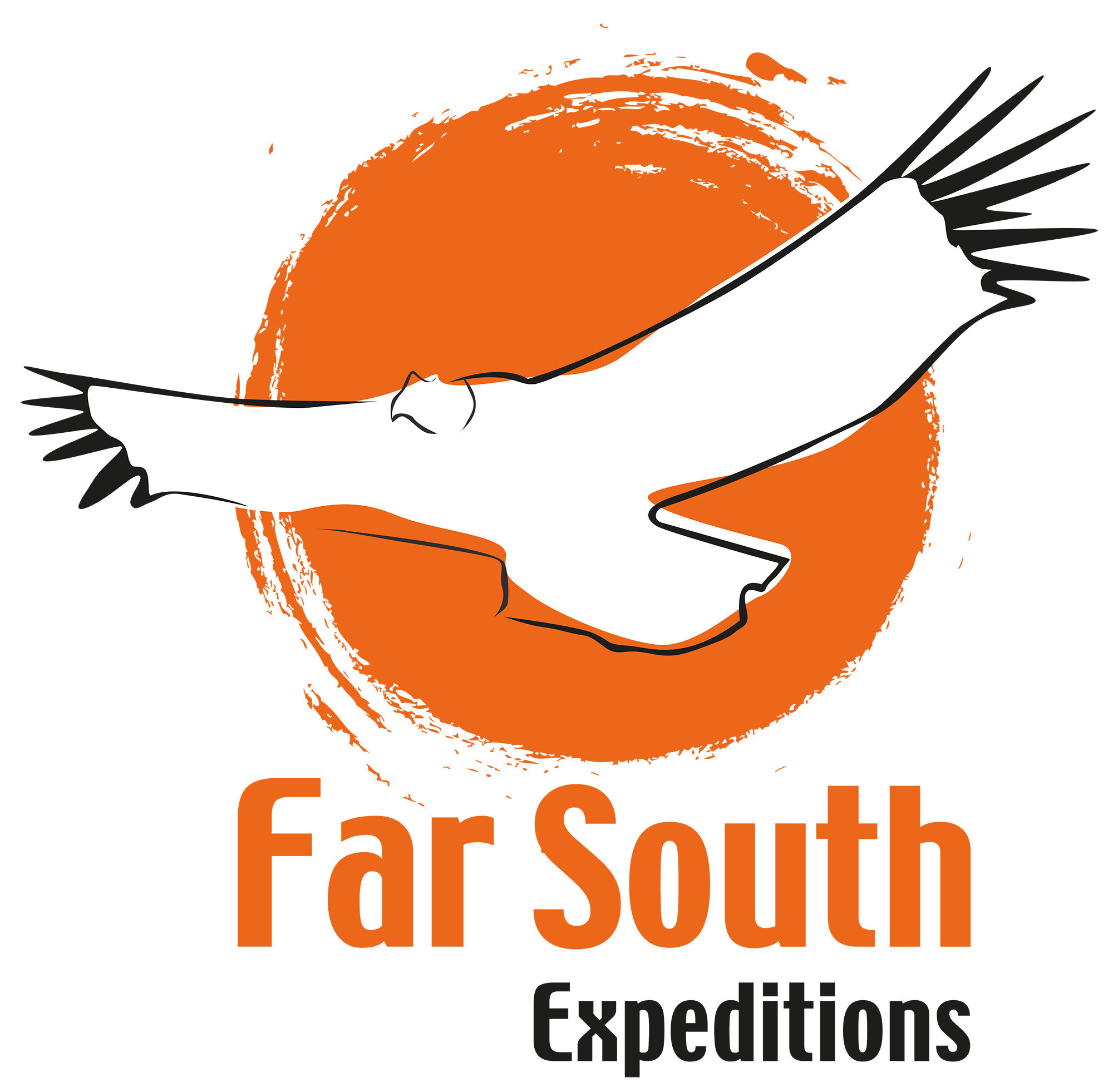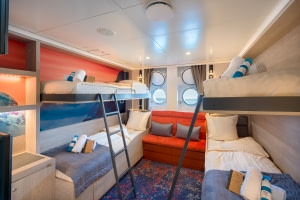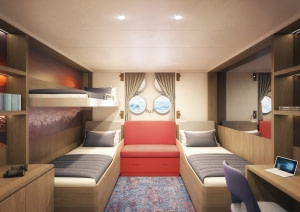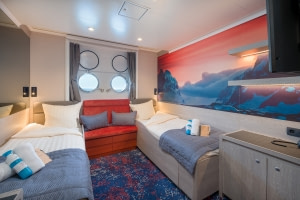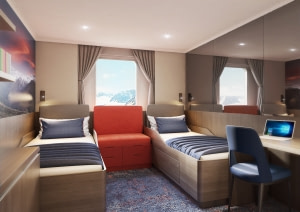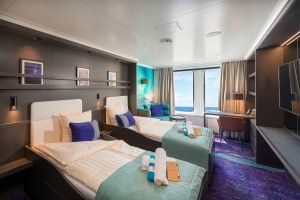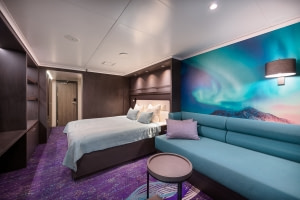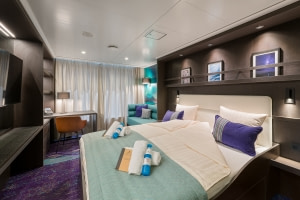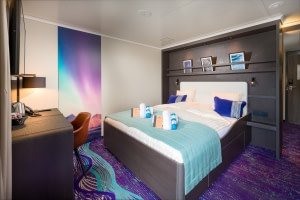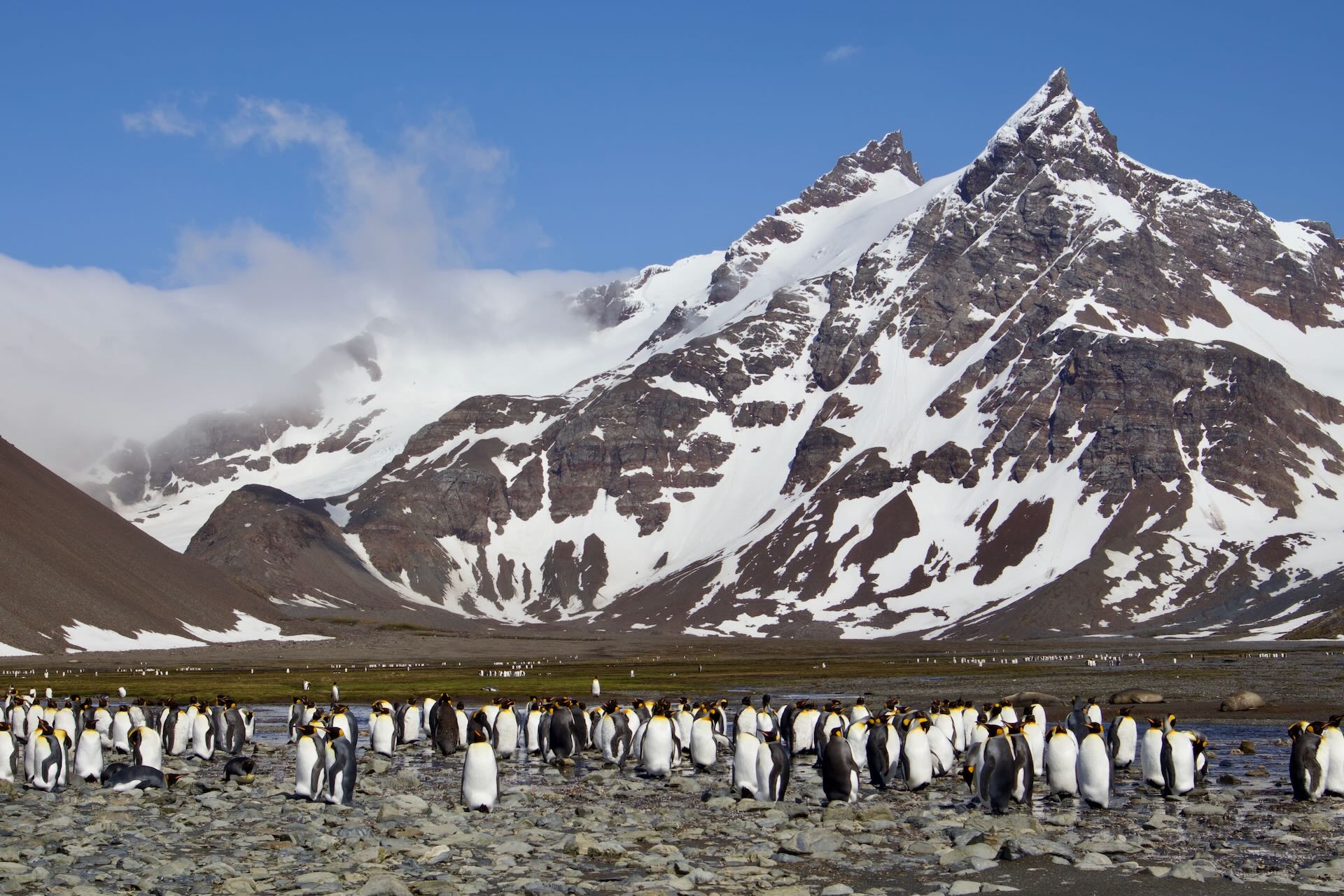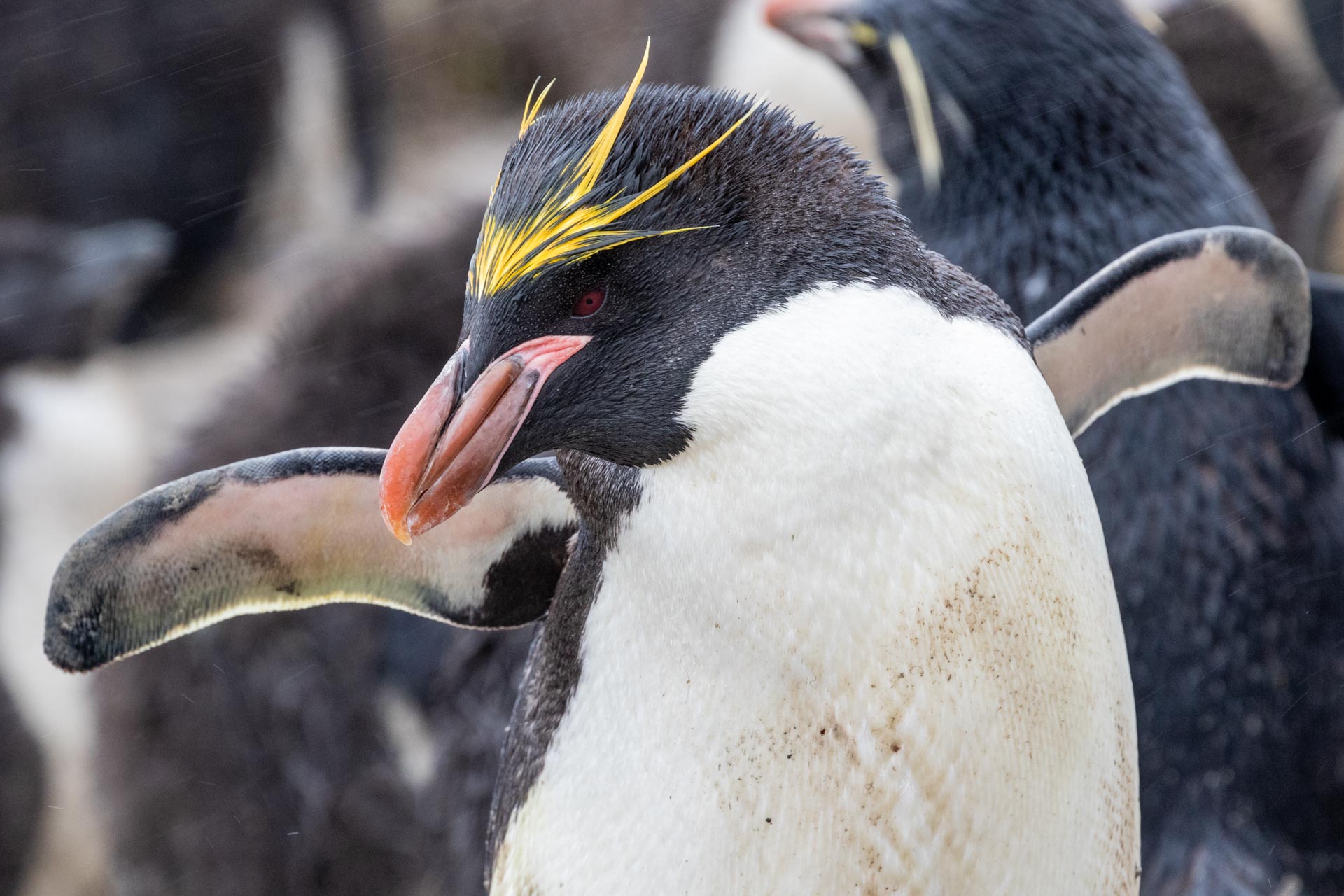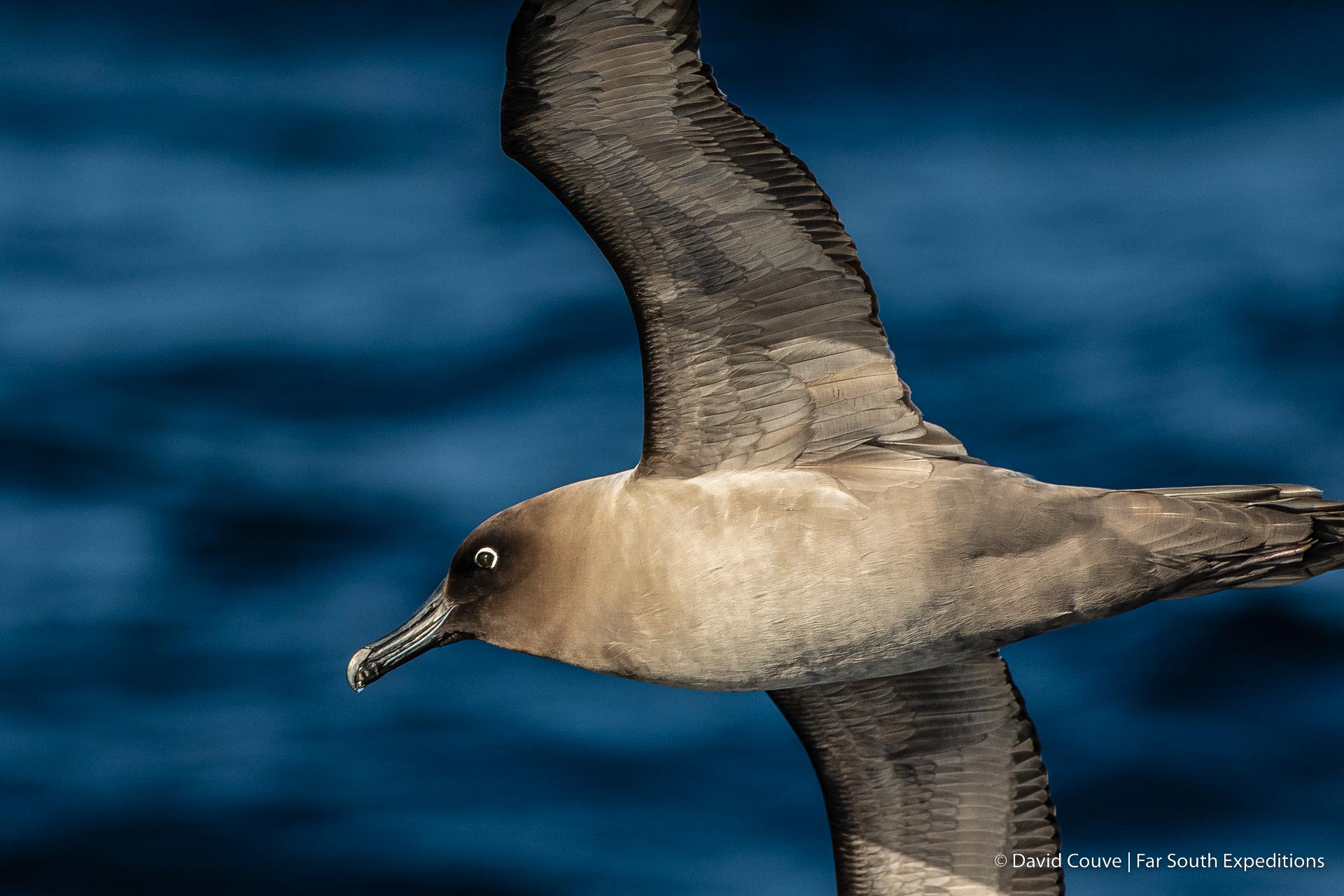Few places compare to South Georgia in terms of exotic wildlife and jaw-dropping scenery, and the Falklands are no different. On this exploratory voyage you can enjoy both, possibly touring the world’s largest black-browed albatross colony while also seeing some of the biggest breeding spots for king penguins and elephant seals on Earth – along with day after day of amazing polar scenery.
South Georgia Grand Tour
Experience the best of the sub-Antarctic
Next departure: 19 October - 7 November, 2022 (20 days)
Starts: Puerto Madryn, Argentina, Ends: Ushuaia, Argentina | Aboard M/V Janssonius
Science Basecamp: Exploring polar science
Our Science Basecamp activities are all about exploring polar science. During this exciting program, you’ll divide into groups and take part in various research activities led by our scientist-guides.
One group might collect various samples from nature, another might make observations of nearby glaciers, and yet another could study rock formations.
Itinerary in Brief
Day 1 • Sandy Argentine beaches
Days 2 & 3 • Sea life, sea birds
Days 4 & 5 • Finding the Falklands: Steeple Jason & Carcass Island. Other sites that we may offer as an alternative: Saunders Island, Westpoint Island & Grave Cove
Days 6 & 7: Once more to the sea
Days 8 to 14: South Georgia journey. Sites you might visit include:
-
-
- Prion Island
- Salisbury Plain, St. Andrews Bay, Gold Harbour
- Fortuna Bay
- Leith Harbour, Stromness, Husvik
- Grytviken
- Cobblers Cove, Godthul
- Royal Bay (Moltke Harbour, Will Point & Brisbane Point)
- Cooper Bay
- Drygalski Fjord
- Annenkov Island
- King Haakon Bay
-
Days 15 to 19: Westward bound
Day 20: Ushuaia
Trip Map
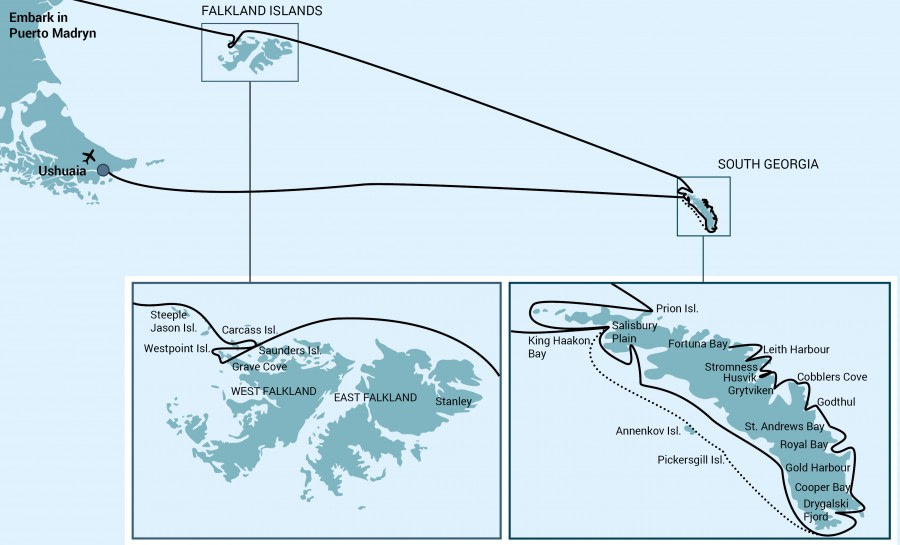
Detailed Itinerary and Activities
Please note: All itineraries are for guidance only. Programs may vary depending on ice, weather, and wildlife conditions. Landings are subject to site availabilities, permissions, and environmental concerns per IAATO regulations. Official sailing plans and landing slots are scheduled with IAATO prior to the start of the season, but the expedition leader determines the final plan. Flexibility is paramount for expedition cruises. The average cruising speed for our vessel is 10.5 knots.
You embark from Puerto Madryn in the afternoon, your prow aimed for the Falkland Islands. Golfo Nuevo is renowned for its visiting southern right whales, so you have a good chance of spotting one as you sail toward the open ocean.
Though you’re now at sea, there’s rarely a lonesome moment here. Several species of bird follow the vessel southeast, such as albatrosses, storm petrels, shearwaters, and diving petrels.
The Falkland Islands offer an abundance of wildlife that is easily approachable, though caution is always advised. These islands are largely unknown gems, the site of a 1982 war between the UK and Argentina. Not only do various species of bird live here, but chances are great you’ll see both Peale’s dolphins and Commerson’s dolphins in the surrounding waters.
During this segment of the voyage, we focus on visiting the following two sites:
Steeple Jason – Home to the world’s largest black-browed albatross colony (roughly 113,000), Steeple Jason is a wild and rarely visited island buffeted by wind and waves. Weather and swell conditions dictate the journey here.
Carcass Island – Despite its name, this island is pleasantly rodent-free and hence bounteous with birdlife and many endemic species. Anything from breeding Magellanic penguins and gentoos to numerous waders and passerine birds (including Cobb’s wrens and tussock-birds) live here.
Other sites that we may offer as an alternative:
Saunders Island – On Saunders Island you can see the black-browed albatross and its sometimes-clumsy landings, along with breeding imperial shags and rockhopper penguins. King penguins, Magellanic penguins, and gentoos are also found here.
Westpoint Island – Landing in a small cove near to the islands house you will be able to walk through the tussac grass and at an abundant breeding colony of black-browed albatrosses where they live side by side with rockhopper penguins.
Grave Cove – Nesting gentoo penguins and excellent hiking opportunities are abound here with the chance to enjoy the scenery and wildlife that the islands has to offer.
En route to South Georgia, you now cross the Antarctic Convergence. The temperature cools considerably within the space of a few hours, and nutritious water rises to the surface of the sea due to colliding water columns. This phenomenon attracts a multitude of seabirds near the ship, including several species of albatross, shearwaters, petrels, prions, and skuas.
Today you arrive at the first South Georgia activity site. Please keep in mind that weather conditions in this area can be challenging, largely dictating the program.
Sites you might visit include:
Prion Island – The home of the great wandering albatrosses. The previous summer’s wandering albatross chicks are almost ready to fledge, and adults are seeking out their old partners after a year and a half at sea.
Salisbury Plain, St. Andrews Bay, Gold Harbour – These sites not only house the three largest king penguin colonies in South Georgia, they’re also three of the world’s largest breeding beaches for southern elephant seals. Only during this time of year do they peak in their breeding cycle. Watch the four-ton bulls keep a constant vigil (and occasionally fight) over territories where dozens of females have just given birth or are about to deliver. You can also see a substantial number of Antarctic fur seals here during the breeding season (December – January).
Fortuna Bay – A beautiful outwash plain from Fortuna Glacier is home to a large number of king penguins and seals. You may have the chance to follow the final leg of Shackleton’s route to the abandoned whaling village of Stromness. This path cuts across the mountain pass beyond Shackleton’s Waterfall, and as the terrain is partly swampy, be prepared to cross a few small streams.
Leith Harbour, Stromness, Husvik – These sites remind us of the scale of the whaling industry in the early 20th century. Elephant and fur seals breed and moult here. Gentoo penguins also occupy the landing sites. Antarctic prions and South Georgia dive petrels may be observed, especially in the area of Husvik.
Grytviken – In this abandoned whaling station, king penguins walk the streets and elephant seals lie around like they own the place – because they basically do. Here you might be able to see the South Georgia Museum as well as Shackleton’s grave.
Cobblers Cove, Godthul – At Cobblers Cove we aim for Rookery Point to see macaroni penguins. Light-mantled sooty albatrosses nest along the coastline and giant petrels can be observed as well. Godthul (Norwegian for “good cove”) was named by Norwegian whalers and seal-hunters and remains such as bones can still be found along the shore line. Beaches are the home of gentoo penguins and seals.
Royal Bay (Moltke Harbour, Will Point & Brisbane Point) – Moltke harbour in Royal Bay was named by the German International Polar Year Expedition in 1882 and some of the remains of their dwellings are still visible. The scenery of Royal Bay is beautiful, dark sandy beaches, followed by the green tussock colors and finally dominated by the snow and ice covered Ross Glacier. Royal Bay one of the windiest bays on the island, zodiac cruising is spectacular. Approx. 30,000 pairs of king penguins live here.
Cooper Bay – Offers the largest chinstrap penguin population and gentoo and also macaroni penguins are present. Antarctic terns, white-chinned petrels, blue-eyed shags and light-mantled sooty albatrosses can be spotted too.
Drygalski Fjord – offers spectacular landscapesas the ships sails the narrow fjord, with ca. 2 kilometer high mountain peaks at a very close distance.
Annenkov Island – Passing Pickersgill Islands we reach the rarely visited Annenkov Island, first discovered by James Cook in 1775 and was later renamed by the Russian expedition of Fabian von Bellingshausen in 1819. A rocky terrain with a variety of ridges, peaks and hills where also fossils have been found.
King Haakon Bay – British explorer Ernest Shackleton reached King Haakon Bay during his journey of 800 sea-miles by open boat “James Caird” from Elephant Island. From here he crossed to Stromness to ask for help to rescue his party at Elephant Island after they had left the Weddell Sea where their ship got crushed by ice. Elephant seals dominate the beaches. Birdwatchers will look out for South Georgia pipits, Antarctic prions as well as common diving and blue petrels.
There may be sea ice on this route, south polar skuas and snow petrels could join the other seabirds such as albatrosses and petrels trailing the vessel. Eventually we reach the Drake Passage and you’re again greeted by the vast array of seabirds remembered from the passage south.
You arrive and disembark in Ushuaia, commonly held to be the world’s most southern city. It is located on the Tierra del Fuego archipelago, nicknamed the “End of the World.” But despite this stopping point, the wealth of memories you’ve made on your Antarctic expedition will travel with you wherever your next adventure lies.
Dates & Rates
Included in this voyage
-
-
- Voyage aboard the indicated vessel as indicated in the itinerary
- All meals throughout the voyage aboard the ship including snacks, coffee and tea.
- All shore excursions and activities throughout the voyage by Zodiac.
- Program of lectures by noted naturalists and leadership by experienced expedition staff.
- Free use of rubber boots and snowshoes.
- Pre-scheduled group transfer from the vessel to the airport in Ushuaia (directly after disembarkation).
- All miscellaneous service taxes and port charges throughout the programme.
- Comprehensive pre-departure material.
-
Excluded from this voyage
-
-
- Any airfare, whether on scheduled or charter flights
- Pre- and post- land arrangements.
- Passport and visa expenses.
- Government arrival and departure taxes.
- Meals ashore.
- Baggage, cancellation and personal insurance (which is strongly recommended).
- Excess baggage charges and all items of a personal nature such as laundry, bar, beverage charges and telecommunication charges.
- The customary gratuity at the end of the voyages for stewards and other service personnel aboard (guidelines will be provided).
-
The Vessel - M/V Janssonius
Janssonius is meeting the latest and highest Lloyd’s Register standards for ice-strengthened cruise ships. Surpassing the requirements of the Polar Code adopted by the International Maritime Organization (IMO), Janssonius represents the most flexible, advanced, innovative touring vessel in the polar regions, thoroughly optimized for exploratory voyages that provide you the utmost first-hand contact with the Arctic and Antarctica.
Specifications
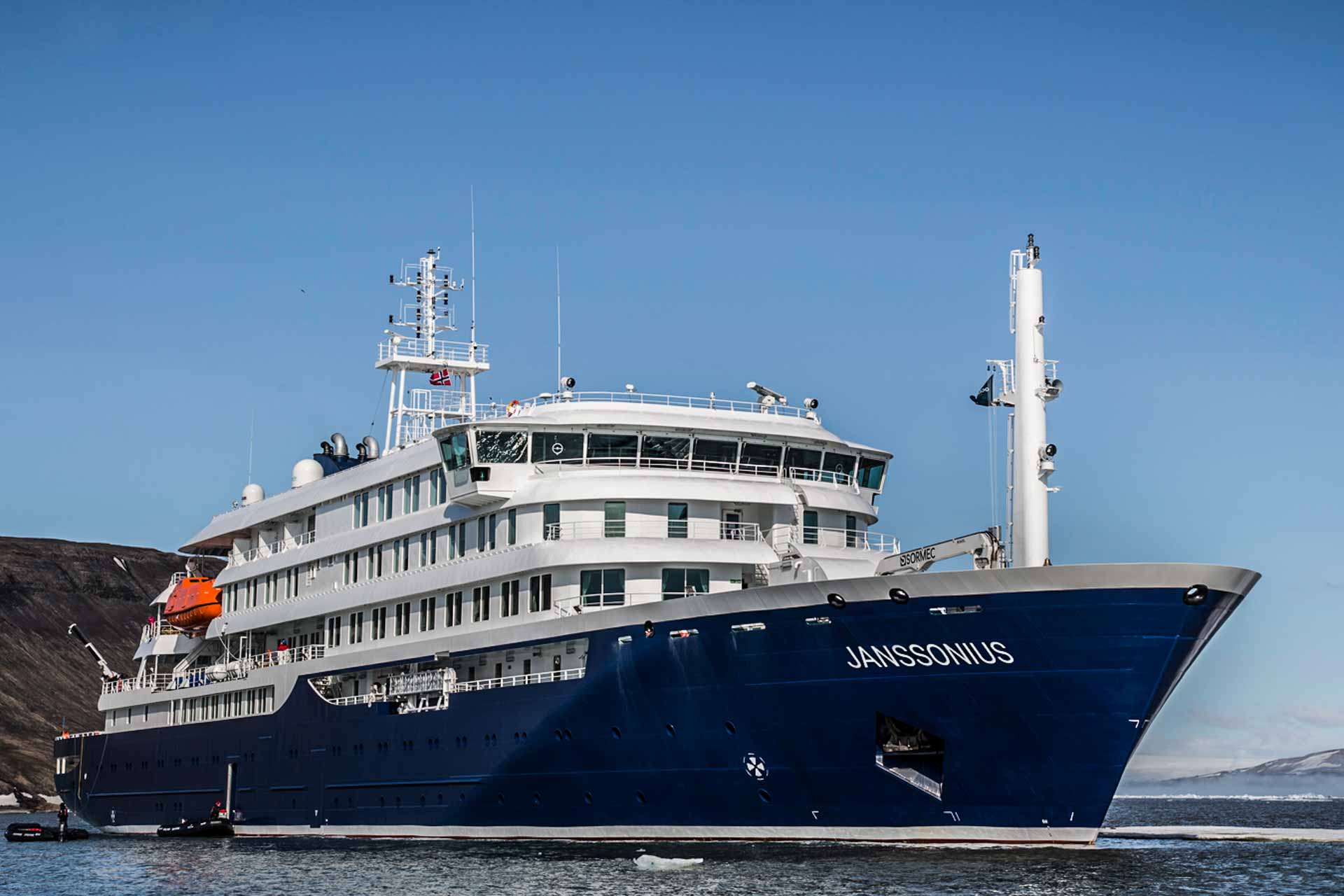
Tour Registration
To book this tour, please complete our online registration form. We will process your booking form and will send you (within 24 hours) a note with space confirmation and a deposit invoice with payment instructions. The deposit amount is US$1,000 per person. Full payment of the tour fee is due 90 days prior to tour departure.
Note: Inquires received on Saturdays, Sundays and Holidays will be replied during the following working day.
Cancellation Policy
Notice of cancellation can only be accepted in writing from the person who signed the booking form and takes effect on the day such noticed is received by us.
Refunds are made according to the following schedule:
-
-
- If cancellation is made 120 days or more before departure date, the deposit less US$ 200 is refundable.
- If cancellation is made between 120 and 60 days before departure, the deposit is not refundable, but any payments covering the balance of the fee will be refunded.
- If cancellation is made fewer than 60 days before departure date, no refund is available.
-
This policy and fee schedule also applies to pre-trip and post trip extensions, as well as any transfers from one tour to another. We strongly recommend the purchase of trip cancellation insurance to protect yourself.

